ARTEMIS was the great Olympian goddess of hunting, wilderness and
wild animals. She was also a goddess of childbirth, and the protectress
of the girl child up to the age of marriage. Her twin brother Apollon
was similarly the protector of the boy child. Together the two gods
were also bringers of sudden death and disease--Artemis targetted women
and girls, and Apollon men and boys.
In ancient art Artemis was usually depicted as a girl dressed in a short knee-length chiton and equipped with a hunting bow and quiver of arrows.
Some of the best known myths featuring the goddess include:--
"Mousa, sing of Artemis, sister of the far-shooter (hekatos), Parthenosthe virgin who delights in arrows (iokheaira), who was fostered with Apollon. She waters her horses from Meles deep in reeds [a river in Lydia], and swifty drives her all-golden chariot through Smyrna to vine-clad Klaros (Claros) where Apollon god of the silver bow (argyrotoxos), sits waiting for far-shooting delighter in arrows (hekatebolon iokheaira).
And so hail to you, Artemis, in my song and to all goddesses as well. Of you first I sing and with you I begin; now that I have begun with you, I will turn to another song."
Homeric Hymn 27 to Artemis :
"I sing of Artemis with shafts are of gold (khryselakatos), strong-voiced (keladeine), the revered virgin (parthenon aidoine), dear-shooting (elaphebolos), delighter in arrows (iokheaira), own sister to Apollon of the golden sword (khrysaor). Over the shadowy hills and windy peaks she draws her golden bow, rejoicing in the chase, and sends out grievous shafts. The tops of the high mountains tremble and the tangled wood echoes awesomely with the outcry of beasts: earth quakes and the sea also where fishes shoal. But the goddess with a bold heart turns every way destroying the race of wild beasts: and when she is satisfied and has cheered her heart, then the huntress who delights in arrows (theroskopos iokheaira) slackens her supple bow and goes to the great house of her dear brother Phoibos Apollon, to the rich land of Delphoi, there to order the lovely dance of the Mousai (Muses) and Kharites (Charites, Graces). There she hangs up her curved bow and her arrows, and heads and leads the dances, gracefully arrayed, while all they utter their heavenly voice, singing how neat-ankled Leto bare children supreme among the immortals both in thought and deed.
Hail to you, children of Zeus and rich-haired Leto! And now I will remember you and another song also."
Homeric Hymn 5 to Aphrodite 18 ff :
"Artemis with shafts of gold (khryselakatos) loves archery and the slaying of wild beasts in the mountains, the lyre also and dancing and strong-voiced song and shady woods and the cities of upright men."
"Of Artemis we hymn--no light thing is it for singers to forget her - whose study is the bow and the shooting of hares and the spacious dance and sport upon the mountains. [The story of her birth and childhood follow, see The Childhood of Artemis for this part of the hymn.] . . .
The fourth time [Artemis shot her bow]--not long was it ere thou didst shoot at the city of unjust me, those who to one another and those who towards strangers wrought many deeds of sin, forward men, on whom thou wilt impress thy grievous wrath. On their cattle plague feeds, on their tilth feeds frost, and the old men cut their hair in mourning over their sons, and their wives either are smitten or die in childbirth, or, if they escape, bear birds whereof none stands on upright ankle.
But on whomsoever thou lookest smiling and gracious, for them the tilth bears the corn-ear abundantly, and abundantly prospers the four-footed breed, and abundant waxes their prosperity: neither do they go to the tomb, save when they carry thither the aged. Nor does faction wound their race--faction which ravages even the well-established houses: but brother's wife and husband's sister set their chairs around one board . . .
Lady, of that number be whosoever is a true friend of mine, and of that number may I be myself, O Queen. And may song be my study forever. In that song shall be the Marriage of Leto; therein thy name shall often-times be sung; therein shall Apollon be and therein all thy labours, and therein thy hounds and thy bow and thy chariot, which lightly carry thee in thy splendour, when thou drivest to the house of Zeus . . .
But when the Nymphai encircle thee in the dance, near the springs of Aigyptian (Egyptian) Inopos [on the island of Delos] or Pitane [in Aiolia or Lakonia]--for Pitane too is thine--or in Limnai [in Lakonia] or where, goddess, thou camest from Skythia to dwell, in Alai Araphenides [i.e. Brauron in Attika], renouncing the rites of the Tauroi [of Skythia], then may not my kine cleave a four-acred fallow field for a wage at the hand of an alien ploughman; else surely lame and weary of neck would they come to the byre, yea even were they of Stymphaian breed, nine years of age, drawing by the horns; which kine are far the best for cleaving a deep furrow; for the god Helios never passes by that beauteous dance, but stays his car to gaze upon the sight, and the lights of day are lengthened.
Which now of islands, what hill finds most favour with thee? What haven? What city? Which of the Nymphai (NYmphs) dost thou love above the rest, and what heroines hast thou taken for thy companions? Say, goddess, thou to me, and I will sing thy saying to others. Of islands, Dolikhe [Ikaria] hath found favour with thee, of cities Perge [in Pamphylia], of hills Taygetos [in Lakedaimonia], the havens of Euripos [Euboia].
And beyond others thou lovest the Nymphe of Gortyn, Britomartis, slayer of stags, the goodly archer . . . Yea and Kyrene thou madest thy comrade, to whom on a time thyself didst give two hunting dogs, with whom the maiden daughter of Hypseus beside the Iolkian tomb won the prize.And the fair-haired [Prokris] wife of Kephalos, son of Deioneus, O Lady, thou madest thy fellow in the chase and fair Antikleia [mother of Odysseus], they say, thou dist love even as thine own eyes. These were the first who wore the gallant bow and arrow-holding quivers on their shoulders; their right shoulders bore the quiver strap, and always the right breast showed bare. Further thou dist greatly commend swift-footed Atalanta, the slayer of boards, daughter of Arkadian Iasios, and taught her hunting with dogs and good archery . . .
Lady of many shrines, of many cities, hail! Khitone (Goddess of the Tunic), sojourner in Miletos; for thee did Neleus [i.e. the founder of Miletos] make his Guide, when he put off with his ships from the land of Kekrops [i.e. Attika].
Khesias (Lady of Khesion) and Imbrasia (Lady of Imbrasos), throned in the highest, to thee in thy shrine did Agamemnon dedicate the rudder of his ship, a charm against ill weather, when thou didst bind the winds for him, what time the Akhaian ships sailed to vex the cities of the Teukroi [i.e. the Trojans], wroth for Rhamnusian Helene.
For thee surely Proitos established two shrines, one of Artemis Kore (Maidenhood) for that thou dist gather for him his maiden daughters, when they were wandering over the Azanian hills; the other he founded in Lousa to Artemis Hemere (the Gentle), because thou tookest from his daughters the spirit of wildness.
For thee, too, the Amazones, whose mind is set on war, in Ephesos beside the sea established an image beneath an oak trunk, and Hippo [an Amazon queen] performed a holy rite for thee, and they themselves, O Oupis Queen, around the image danced a war-dance--first in shields and armour, and again in a circle arraying a spacious choir. And the loud pipes thereto piped shrill accompaniment, that they might foot the dance together (for not yet did they pierce the bones of the fawn [to create flutes], Athene's handiwork, a bane to the deer). And the echo reached unto Sardis and to the Berekynthian range [in Phrygia]. And they with their feet geat loudly and therewith their quivers rattled. And afterwards around that image was raised a shrine of broad foundations. That it shall dawn behold nothing more divine, naught richer. Easily would it outdo Pytho [Delphoi].
Wherefore in this madness insolent Lygdamis threatened that he would lay it waste, and brought against it a host of Kimmerians which milk mares, in number as the sand; who have their homes hard by the Straights of the cow, daughter of Inakhos. Ah! Foolish among kings, how greatly he sinned! For not destined to return again to Skythia was either he or any other of those whose wagons stood in the Kaytrian plain [of Lydia]; for thy shafts are ever more set as a defense before Ephesos. O Mounikhia (Lady of Mounykhia), Limenoskope (Watcher of Harbours), hail, Pheraia (Lady of Pherai)!
Let none disparage Artemis. For Oineus dishonoured her altar and no pleasant struggles came upon his city.
Nor let any contend with her in shooting of stags or in archery. For the son of Atreus [Agamemnon] vaunted him not that he suffered small requital. Neither let any woo the Maiden; for not Otos, nor Orion wooed her to their own good. Nor let any shun the yearly dance; for not tearless to Hippo [an Amazon queen] was her refusal to dance around the altar. Hail, great queen, and graciously greet my song."
"To Prothyraia [Artemis], Fumigation from Storax. O venerable Goddess, hear my prayer, for labour pains are thy peculiar care. In thee, when stretched upon the bed of grief, the sex, as in a mirror, view relief. Guard of the race, endued with gentle mind, to helpless youth benevolent and kind; benignant nourisher; great nature's key belongs to no divinity but thee. Thou dwellest with all immanifest to sight, and solemn festivals are thy delight. Thine is the task to loose the virgin's zone and thou in every work art seen and known. With births you sympathise, though pleased to see the numerous offspring of fertility. When racked with labour pangs, and sore distressed the sex invoke thee, as the soul's sure rest; for thou Eileithyia alone canst give relief to pain, which art attempts to ease, but tries in vain. Artemis Eileithyia, venerable power, who bringest relief in labour's dreadful hour; hear, Prothyraia and make the infant race thy constant care."
Orphic Hymn 36 to Artemis :
"To Artemis, Fumigation from Manna. Hear me, Zeus' daughter, celebrated queen, Bromia and Titanis, of a noble mien: in darts rejoicing, and on all to shine, torch-bearing Goddess, Diktynna divine. Over births presiding, and thyself a maid, to labour pangs imparting ready aid: dissolver of the zone, and wrinkled care, fierce huntress, glorying in the sylvan war: swift in the course, in dreadful arrows skilled, wandering by night, rejoicing in the field: of manly form, erect, of bounteous mind, illustrious Daimon, nurse of humankind: immortal, earthly, bane of monsters fell, 'tis thine, blest maid, on woody mounts to dwell: foe of the stag, whom woods and dogs delight, in endless youth you flourish fair and bright. O universal queen, august, divine, a various form, Kydonian power, is thine. Dread guardian Goddess, with benignant mind, auspicious come, to mystic rites inclined; give earth a store of beauteous fruits to bear, send gentle peace, and health with lovely hair, and to the mountains drive disease and care."
Homer, Odyssey 6. 102 ff (trans. Shewring) (Greek epic C8th B.C.) :
"With head and forehead Artemis overtops the rest [of her companion Nymphai], and though all are lovely, there is no mistaking which is she."
Homer, Odyssey 6. 151 ff :
"[Odysseus addresses Nausikaa:] ‘You are most like Artemis, daughter of sovereign Zeus; you are tall as she is, lovely as she is, you have her air.’"
Homer, Odyssey 17. 37 & 19. 54 :
"Penelope came from her room, looking like Artemis [i.e. in chastity] or like golden Aphrodite [i.e. in beauty]."
Apollonius Rhodius, Argonautica 3. 879 ff (trans. Rieu) (Greek epic C3rd B.C.) :
"Artemis, standing in her golden chariot after she has bathed in the gently water of Parthenios or the streams of Amnisos, and driving off with her fast-trotting deer over the hills and far away to some rich-scented sacrifice. Attendant Nymphai have gathered at the source of Amnisos or flocked in from the glens and upland springs to follow her; and fawning beasts whimper in homage and tremble as she passes by."
Callimachus, Hymn 3 to Artemis 10 ff (trans. Mair) (Greek poet C3rd B.C.) :
"Give me [Artemis] arrows and a bow . . . and give me to gird me in a tunic with embroidered border reaching to the knee, that I may slay wild beasts."
Pausanias, Description of Greece 5. 19. 5 (trans. Jones) (Greek travelogue C2nd A.D.) :
"[Amongst the figures depicted on the chest of Kypselos dedicated at Olympia:] Artemis has wings on her shoulders . . . in her right hand she grips a leopard, in her left a lion."
Pausanias, Description of Greece 8. 37. 1 :
"[From a description of a cult statue:] Artemis wrapped in the skin of a deer, and carrying a quiver on her shoulders, while in one hand she holds a torch, in the other two serpents; by her side a bitch, of a breed suitable for hunting, is lying down."
Ovid, Metamorphoses 3. 138 ff (trans. Melville) (Roman epic C1st B.C. to C1st A.D.) :
"She [Artemis] stood taller, a head taller than them all [her attendant Nymphai]."
Nonnus, Dionysiaca 48. 302 ff (trans. Rouse) (Greek epic C5th A.D.) :
"[Artemis] and maiden Aura mounted the car [Artemis' chariot], took reins and whip and drove the horned team [of deer] like a tempest. The unveiled daughters of everflowing Okeanos her servants made haste to accompany the Archeress: one moved her swift knees as her queen's forerunner, another tucked up her tunic and ran level not far off, a third laid a hand on the basket of the swiftmoving car and ran alongside. Archeress diffusing radiance from her face stood shining above her attendants . . . The goddess [Artemis] leapt out of her car [of her chariot]; Oupis took the bow from her shoulders, and Hekaerge the quiver; the daughters of Okeanos took off the well-strung hunting nets, and another took charge of the dogs; Loxo loosed the boots from her feet."
In ancient art Artemis was usually depicted as a girl dressed in a short knee-length chiton and equipped with a hunting bow and quiver of arrows.
Some of the best known myths featuring the goddess include:--
- Her birth, immediately following which she assisted her mother in the birth of her twin brother Apollon;
- The Trojan War where she was beaten by Hera in an angry contest of the gods;
- The hunter Aktaion who encountered the goddess whilst she was bathing and was turned into a stag;
- The Aloadai giants who attempted to storm Olympos but were tricked by Artemis into killing each other;
- The sacrifice of Iphigeneia whom King Agamemnon offered to her for the passage of the Greek fleet to Troy;
- The giant Orion, a close companion of the goddess, who was slain by the goddess or her jealous brother;
- The Kalydonian boar sent by Artemis to ravage Kaldyon;
- The nymph Kallisto, a companion of Artemis, who was seduced by Zeus in the guise of the goddess.
|
| Her name at Sparta was Orthia,
with reference to the phallus, or because her statue stood erect.
According to another tradition, Orestes and Iphigeneia concealed the
image of the Taurian goddess in a bundle of brushwood, and carried it to
Aricia in Latium. Iphigeneia, who was at first to have been sacrificed
to Artemis, and then became her priestess, was afterwards identified
with the goddess (Herod. iv. 103; Paus. i. 43. § 1), who was worshipped
in some parts of Greece, as at Hermione, under the name of Iphigeneia.
(Paus. ii. 35. § 1.) Some traditions stated, that Artemis made
Iphigeneia immortal, in the character of Hecate, the goddess of the
moon. A kindred divinity, if not the same as the Taurian Artemis, is Artemis tauropolos, whose worship was connected with bloody sacrifices, and who produced madness in the minds of men, at least the chorus in the Ajax of Sophocles, describes the madness of Ajax as the work of this divinity. In the legends about the Taurian Artemis, it seems that separate local traditions of Greece are mixed up with the legends of some Asiatic divinity, whose symbol in the heaven was the moon, and on the earth the cow. 4. The Ephesian Artemis was a divinity totally distinct from the Greek goddess of the same name. She seems to have been the personification of the fructifying and all-nourishing powers of nature. It is an opinion almost universally adopted, that she was an ancient Asiatic divinity whose worship the Greeks found established in Ionia, when they settled there, and that, for some resemblance they discovered, they applied to her the name of Artemis. As soon as this identity of the Asiatic goddess with the Greek Artemis was recognised, other features, also originally peculiar to the Greek Artemis, were transferred to her; and thus she is called a daughter of Leto, who gave birth to her in the neighbourhood of Ephesus. Her original character is sufficiently clear from the fact, that her priests were eunuchs, and that her image in the magnificent temple of Ephesus represented her with many breasts (polumastos). The whole figure of the goddess resembled a mummy : her head was surmounted with a mural crown (corona muralis), and the lower part of her body, which ended in a point, like a pyramid upside down, was covered with figures of mystical animals. (Strab. xiv. p. 641; Paus. iv. 31. § 6, vii. 5. § 2., The symbol of this divinity was a bee, and her highpriest bore the name of king (essên). Her worship was said to have been established at Ephesus by the Amazons. (Paus. ii. 7. § 4, viii. 12. § 1; Hesych. and Suid. s. v. essên.) Respecting some other divinities, or attributes of divinities, which were likewise regarded as identical with Artemis in Greece, see Britomartis, Dictynna, and EileithyiaI. The Romans identified their goddess Diana with the Greek Artemis, and at a comparatively early time they transferred to their own goddess all the peculiar features of the Greek Artemis. The worship of Artemis was universal in all Greece, in Delos, Crete, Sicily, and southern Italy, but more especially in Arcadia and the whole of the Peloponnesus. The sacrifices offered to the Brauronian Artemis consisted of stags and goats; in Thrace dogs were offered to Artemis. Among the animals sacred to the Greek Artemis we may mention the stag, boar, dog, and others; the fir-tree was likewise sacred to her. It is impossible to trace the various relations in which Artemis appears to us to one common source, or to one fundamental idea : the very manner in which such a complicated mythus was formed renders the attempt futile, or, to say the least, forced. In the case of Artemis, it is evident, that new elements and features were added in various places to the ancient local mythus; the worship of one divinity is identified with that of another, and the legends of the two are mixed up into one, or those of the one are transferred to the other, whose legends then sink into oblivion. The representations of the Greek Artemis in works of art are different accordingly as she is represented either as a huntress, or as the goddess of the moon; yet in either case she appears as a youthful and vigorous divinity, as becomes the sister of Apollo. As the huntress, she is tall, nimble, and has small hips; her forehead is high, her eyes glancing freely about, and her hair tied up behind in such a manner, that some locks float down her neck; her breast is covered, and the legs up to the knees are naked, the rest being covered by the chlamys. Her attributes are the bow, quiver, and arrows, or a spear, stags, and dogs. As the goddess of the moon, she wears a long robe which reaches down to her feet, a veil covers her head, and above her forehead rises the crescent of the moon. In her hand she often appears holding a torch. Source: Dictionary of Greek and Roman Biography and Mythology. |
HYMNS TO ARTEMIS
I) THE HOMERIC HYMNS
Homeric Hymn 9 to Artemis (trans. Evelyn-White) (Greek epic C7th to 4th B.C.) :"Mousa, sing of Artemis, sister of the far-shooter (hekatos), Parthenosthe virgin who delights in arrows (iokheaira), who was fostered with Apollon. She waters her horses from Meles deep in reeds [a river in Lydia], and swifty drives her all-golden chariot through Smyrna to vine-clad Klaros (Claros) where Apollon god of the silver bow (argyrotoxos), sits waiting for far-shooting delighter in arrows (hekatebolon iokheaira).
And so hail to you, Artemis, in my song and to all goddesses as well. Of you first I sing and with you I begin; now that I have begun with you, I will turn to another song."
Homeric Hymn 27 to Artemis :
"I sing of Artemis with shafts are of gold (khryselakatos), strong-voiced (keladeine), the revered virgin (parthenon aidoine), dear-shooting (elaphebolos), delighter in arrows (iokheaira), own sister to Apollon of the golden sword (khrysaor). Over the shadowy hills and windy peaks she draws her golden bow, rejoicing in the chase, and sends out grievous shafts. The tops of the high mountains tremble and the tangled wood echoes awesomely with the outcry of beasts: earth quakes and the sea also where fishes shoal. But the goddess with a bold heart turns every way destroying the race of wild beasts: and when she is satisfied and has cheered her heart, then the huntress who delights in arrows (theroskopos iokheaira) slackens her supple bow and goes to the great house of her dear brother Phoibos Apollon, to the rich land of Delphoi, there to order the lovely dance of the Mousai (Muses) and Kharites (Charites, Graces). There she hangs up her curved bow and her arrows, and heads and leads the dances, gracefully arrayed, while all they utter their heavenly voice, singing how neat-ankled Leto bare children supreme among the immortals both in thought and deed.
Hail to you, children of Zeus and rich-haired Leto! And now I will remember you and another song also."
Homeric Hymn 5 to Aphrodite 18 ff :
"Artemis with shafts of gold (khryselakatos) loves archery and the slaying of wild beasts in the mountains, the lyre also and dancing and strong-voiced song and shady woods and the cities of upright men."
II) HELLENISTIC HYMNS
Callimachus, Hymn 3 to Artemis (trans. Mair) (Greek poet C3rd B.C.) :"Of Artemis we hymn--no light thing is it for singers to forget her - whose study is the bow and the shooting of hares and the spacious dance and sport upon the mountains. [The story of her birth and childhood follow, see The Childhood of Artemis for this part of the hymn.] . . .
The fourth time [Artemis shot her bow]--not long was it ere thou didst shoot at the city of unjust me, those who to one another and those who towards strangers wrought many deeds of sin, forward men, on whom thou wilt impress thy grievous wrath. On their cattle plague feeds, on their tilth feeds frost, and the old men cut their hair in mourning over their sons, and their wives either are smitten or die in childbirth, or, if they escape, bear birds whereof none stands on upright ankle.
But on whomsoever thou lookest smiling and gracious, for them the tilth bears the corn-ear abundantly, and abundantly prospers the four-footed breed, and abundant waxes their prosperity: neither do they go to the tomb, save when they carry thither the aged. Nor does faction wound their race--faction which ravages even the well-established houses: but brother's wife and husband's sister set their chairs around one board . . .
Lady, of that number be whosoever is a true friend of mine, and of that number may I be myself, O Queen. And may song be my study forever. In that song shall be the Marriage of Leto; therein thy name shall often-times be sung; therein shall Apollon be and therein all thy labours, and therein thy hounds and thy bow and thy chariot, which lightly carry thee in thy splendour, when thou drivest to the house of Zeus . . .
But when the Nymphai encircle thee in the dance, near the springs of Aigyptian (Egyptian) Inopos [on the island of Delos] or Pitane [in Aiolia or Lakonia]--for Pitane too is thine--or in Limnai [in Lakonia] or where, goddess, thou camest from Skythia to dwell, in Alai Araphenides [i.e. Brauron in Attika], renouncing the rites of the Tauroi [of Skythia], then may not my kine cleave a four-acred fallow field for a wage at the hand of an alien ploughman; else surely lame and weary of neck would they come to the byre, yea even were they of Stymphaian breed, nine years of age, drawing by the horns; which kine are far the best for cleaving a deep furrow; for the god Helios never passes by that beauteous dance, but stays his car to gaze upon the sight, and the lights of day are lengthened.
Which now of islands, what hill finds most favour with thee? What haven? What city? Which of the Nymphai (NYmphs) dost thou love above the rest, and what heroines hast thou taken for thy companions? Say, goddess, thou to me, and I will sing thy saying to others. Of islands, Dolikhe [Ikaria] hath found favour with thee, of cities Perge [in Pamphylia], of hills Taygetos [in Lakedaimonia], the havens of Euripos [Euboia].
And beyond others thou lovest the Nymphe of Gortyn, Britomartis, slayer of stags, the goodly archer . . . Yea and Kyrene thou madest thy comrade, to whom on a time thyself didst give two hunting dogs, with whom the maiden daughter of Hypseus beside the Iolkian tomb won the prize.And the fair-haired [Prokris] wife of Kephalos, son of Deioneus, O Lady, thou madest thy fellow in the chase and fair Antikleia [mother of Odysseus], they say, thou dist love even as thine own eyes. These were the first who wore the gallant bow and arrow-holding quivers on their shoulders; their right shoulders bore the quiver strap, and always the right breast showed bare. Further thou dist greatly commend swift-footed Atalanta, the slayer of boards, daughter of Arkadian Iasios, and taught her hunting with dogs and good archery . . .
Lady of many shrines, of many cities, hail! Khitone (Goddess of the Tunic), sojourner in Miletos; for thee did Neleus [i.e. the founder of Miletos] make his Guide, when he put off with his ships from the land of Kekrops [i.e. Attika].
Khesias (Lady of Khesion) and Imbrasia (Lady of Imbrasos), throned in the highest, to thee in thy shrine did Agamemnon dedicate the rudder of his ship, a charm against ill weather, when thou didst bind the winds for him, what time the Akhaian ships sailed to vex the cities of the Teukroi [i.e. the Trojans], wroth for Rhamnusian Helene.
For thee surely Proitos established two shrines, one of Artemis Kore (Maidenhood) for that thou dist gather for him his maiden daughters, when they were wandering over the Azanian hills; the other he founded in Lousa to Artemis Hemere (the Gentle), because thou tookest from his daughters the spirit of wildness.
For thee, too, the Amazones, whose mind is set on war, in Ephesos beside the sea established an image beneath an oak trunk, and Hippo [an Amazon queen] performed a holy rite for thee, and they themselves, O Oupis Queen, around the image danced a war-dance--first in shields and armour, and again in a circle arraying a spacious choir. And the loud pipes thereto piped shrill accompaniment, that they might foot the dance together (for not yet did they pierce the bones of the fawn [to create flutes], Athene's handiwork, a bane to the deer). And the echo reached unto Sardis and to the Berekynthian range [in Phrygia]. And they with their feet geat loudly and therewith their quivers rattled. And afterwards around that image was raised a shrine of broad foundations. That it shall dawn behold nothing more divine, naught richer. Easily would it outdo Pytho [Delphoi].
Wherefore in this madness insolent Lygdamis threatened that he would lay it waste, and brought against it a host of Kimmerians which milk mares, in number as the sand; who have their homes hard by the Straights of the cow, daughter of Inakhos. Ah! Foolish among kings, how greatly he sinned! For not destined to return again to Skythia was either he or any other of those whose wagons stood in the Kaytrian plain [of Lydia]; for thy shafts are ever more set as a defense before Ephesos. O Mounikhia (Lady of Mounykhia), Limenoskope (Watcher of Harbours), hail, Pheraia (Lady of Pherai)!
Let none disparage Artemis. For Oineus dishonoured her altar and no pleasant struggles came upon his city.
Nor let any contend with her in shooting of stags or in archery. For the son of Atreus [Agamemnon] vaunted him not that he suffered small requital. Neither let any woo the Maiden; for not Otos, nor Orion wooed her to their own good. Nor let any shun the yearly dance; for not tearless to Hippo [an Amazon queen] was her refusal to dance around the altar. Hail, great queen, and graciously greet my song."
III) THE ORPHIC HYMNS
Orphic Hymn 2 to Prothhyraea (trans. Taylor) (Greek hymns C3rd B.C. to 2nd A.D.) :"To Prothyraia [Artemis], Fumigation from Storax. O venerable Goddess, hear my prayer, for labour pains are thy peculiar care. In thee, when stretched upon the bed of grief, the sex, as in a mirror, view relief. Guard of the race, endued with gentle mind, to helpless youth benevolent and kind; benignant nourisher; great nature's key belongs to no divinity but thee. Thou dwellest with all immanifest to sight, and solemn festivals are thy delight. Thine is the task to loose the virgin's zone and thou in every work art seen and known. With births you sympathise, though pleased to see the numerous offspring of fertility. When racked with labour pangs, and sore distressed the sex invoke thee, as the soul's sure rest; for thou Eileithyia alone canst give relief to pain, which art attempts to ease, but tries in vain. Artemis Eileithyia, venerable power, who bringest relief in labour's dreadful hour; hear, Prothyraia and make the infant race thy constant care."
Orphic Hymn 36 to Artemis :
"To Artemis, Fumigation from Manna. Hear me, Zeus' daughter, celebrated queen, Bromia and Titanis, of a noble mien: in darts rejoicing, and on all to shine, torch-bearing Goddess, Diktynna divine. Over births presiding, and thyself a maid, to labour pangs imparting ready aid: dissolver of the zone, and wrinkled care, fierce huntress, glorying in the sylvan war: swift in the course, in dreadful arrows skilled, wandering by night, rejoicing in the field: of manly form, erect, of bounteous mind, illustrious Daimon, nurse of humankind: immortal, earthly, bane of monsters fell, 'tis thine, blest maid, on woody mounts to dwell: foe of the stag, whom woods and dogs delight, in endless youth you flourish fair and bright. O universal queen, august, divine, a various form, Kydonian power, is thine. Dread guardian Goddess, with benignant mind, auspicious come, to mystic rites inclined; give earth a store of beauteous fruits to bear, send gentle peace, and health with lovely hair, and to the mountains drive disease and care."
|
|
|
| SCULPTURE see Artemis Cult 1, Artemis Cult 2, Artemis Cult 3, Artemis Cult 4 |
PHYSICAL DESCRIPTIONS OF ARTEMIS
Classical literature offers only a few, brief descriptions of the physical characteristics of the gods.Homer, Odyssey 6. 102 ff (trans. Shewring) (Greek epic C8th B.C.) :
"With head and forehead Artemis overtops the rest [of her companion Nymphai], and though all are lovely, there is no mistaking which is she."
Homer, Odyssey 6. 151 ff :
"[Odysseus addresses Nausikaa:] ‘You are most like Artemis, daughter of sovereign Zeus; you are tall as she is, lovely as she is, you have her air.’"
Homer, Odyssey 17. 37 & 19. 54 :
"Penelope came from her room, looking like Artemis [i.e. in chastity] or like golden Aphrodite [i.e. in beauty]."
Apollonius Rhodius, Argonautica 3. 879 ff (trans. Rieu) (Greek epic C3rd B.C.) :
"Artemis, standing in her golden chariot after she has bathed in the gently water of Parthenios or the streams of Amnisos, and driving off with her fast-trotting deer over the hills and far away to some rich-scented sacrifice. Attendant Nymphai have gathered at the source of Amnisos or flocked in from the glens and upland springs to follow her; and fawning beasts whimper in homage and tremble as she passes by."
Callimachus, Hymn 3 to Artemis 10 ff (trans. Mair) (Greek poet C3rd B.C.) :
"Give me [Artemis] arrows and a bow . . . and give me to gird me in a tunic with embroidered border reaching to the knee, that I may slay wild beasts."
Pausanias, Description of Greece 5. 19. 5 (trans. Jones) (Greek travelogue C2nd A.D.) :
"[Amongst the figures depicted on the chest of Kypselos dedicated at Olympia:] Artemis has wings on her shoulders . . . in her right hand she grips a leopard, in her left a lion."
Pausanias, Description of Greece 8. 37. 1 :
"[From a description of a cult statue:] Artemis wrapped in the skin of a deer, and carrying a quiver on her shoulders, while in one hand she holds a torch, in the other two serpents; by her side a bitch, of a breed suitable for hunting, is lying down."
Ovid, Metamorphoses 3. 138 ff (trans. Melville) (Roman epic C1st B.C. to C1st A.D.) :
"She [Artemis] stood taller, a head taller than them all [her attendant Nymphai]."
Nonnus, Dionysiaca 48. 302 ff (trans. Rouse) (Greek epic C5th A.D.) :
"[Artemis] and maiden Aura mounted the car [Artemis' chariot], took reins and whip and drove the horned team [of deer] like a tempest. The unveiled daughters of everflowing Okeanos her servants made haste to accompany the Archeress: one moved her swift knees as her queen's forerunner, another tucked up her tunic and ran level not far off, a third laid a hand on the basket of the swiftmoving car and ran alongside. Archeress diffusing radiance from her face stood shining above her attendants . . . The goddess [Artemis] leapt out of her car [of her chariot]; Oupis took the bow from her shoulders, and Hekaerge the quiver; the daughters of Okeanos took off the well-strung hunting nets, and another took charge of the dogs; Loxo loosed the boots from her feet."
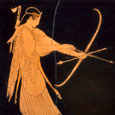
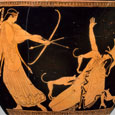
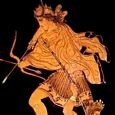
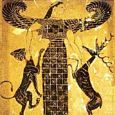
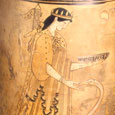
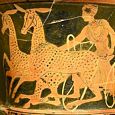
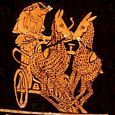
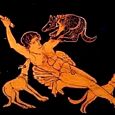
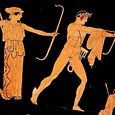
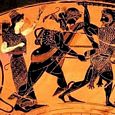
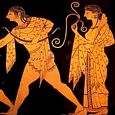
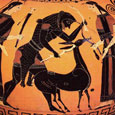
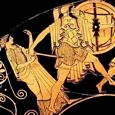
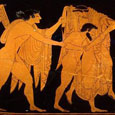
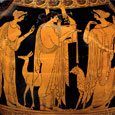
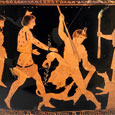
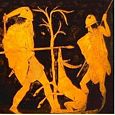
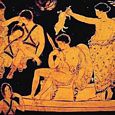
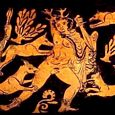
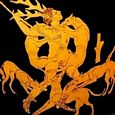
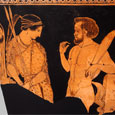
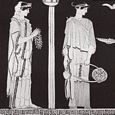
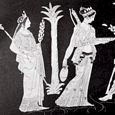
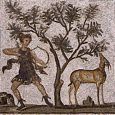
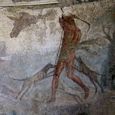
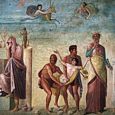
Αυτό το σχόλιο αφαιρέθηκε από έναν διαχειριστή ιστολογίου.
ΑπάντησηΔιαγραφή